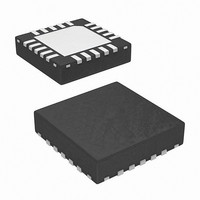ISL97675IRZ-TK Intersil, ISL97675IRZ-TK Datasheet - Page 12

ISL97675IRZ-TK
Manufacturer Part Number
ISL97675IRZ-TK
Description
IC LED DVR PWM CTRL 4CH 20QFN
Manufacturer
Intersil
Type
Backlight, White LEDr
Datasheet
1.ISL97675IRZ-TK.pdf
(20 pages)
Specifications of ISL97675IRZ-TK
Topology
PWM, Step-Up (Boost)
Number Of Outputs
4
Internal Driver
Yes
Type - Primary
Backlight
Frequency
600kHz, 1.2MHz
Voltage - Supply
4.5 V ~ 26 V
Voltage - Output
45V
Mounting Type
Surface Mount
Package / Case
20-VQFN
Operating Temperature
-40°C ~ 85°C
Current - Output / Channel
30mA
Internal Switch(s)
Yes
Efficiency
92%
Lead Free Status / RoHS Status
Lead free / RoHS Compliant
Other names
ISL97675IRZ-TKTR
Theory of Operation
PWM Boost Converter
The current mode PWM boost converter produces the
minimal voltage needed to enable the LED stack with the
highest forward voltage drop to run at the programmed
current. The ISL97675 employs current mode control
boost architecture that has a fast current sense loop and
a slow voltage feedback loop. Such architecture achieves
a fast transient response that is essential for the
notebook backlight application. The input power may
instantly change when the user switches from a drained
battery to a AC/DC adapter without causing any flicker in
the display backlight. The ISL97675 is capable of
boosting up to 45V and typically can drive 13
(3.2V/20mA) LEDs in series on each of the 4 channels.
OVP
The Overvoltage Protection (OVP) pin has a primary
function of setting the overvoltage trip level.
The ISL97675 OVP threshold is set by R
R
V
The ISL97675 has a patent pending switching
architecture that uses the OVP block for feedback
monitoring, hence allowing very low PWM dimming duty
cycle operation. As a result, the overvoltage trip level
also limits the V
100% of the V
Allowable V
For example, if 10 LEDs are used with the worst case V
of 35V, and R
OVP level is set at 40V, then the allowed V
between 25.6V and 40V. If the requirement is changed to
6 LEDs/channel for a maximum V
level must be reduced according to Equation 2 to
accommodate the new reduced output voltage.
Otherwise, the headroom control will be disturbed and
the channel voltage may be higher and prevent the
driver from operating properly.
The ratio of the OVP capacitors should be the inverse of
the OVP resistors. For example, if R
then C
C
Enable
An EN signal is required to enable the internal regulator
for normal operation. If there is no signal longer than
28ms, the device will enter shutdown.
Power Sequence
There is no specific power sequence requirement for the
ISL97675. The EN signal can be tied to V
VDDIO as it will prevent the device from powering up.
OUT
LOWER
UPPER
_OVP
UPPER
= 100pF then C
such that:
=
OUT
/C
1.21V
UPPER
OUT
LOWER
=
OUT
64% to 100% of V
_OVP and the equation
×
and R
(
regulation range between 64% and
R
= 1/33. For example , if
UPPER
LOWER
LOWER
12
+
R
= 3.3nF.
LOWER
are chosen such that the
OUT
OUT
UPPER
_OVP
of 21V, then the OVP
)
⁄
R
UPPER
/R
LOWER
IN
OUT
is:
LOWER
but not the
range is
and
= 33/1,
(EQ. 1)
(EQ. 2)
ISL97675
OUT
Current Matching and Current Accuracy
Each channel of the LED current is regulated by the
current source circuit, as shown in Figure 18.
The LED peak current is set by translating the R
current to the output with a scaling factor of 392/R
The drain terminals of the current source MOSFETs are
designed to run at ~ 500mV to minimize power loss. The
sources of errors for the channel-to-channel current
matching are due to internal mismatches, offsets and the
external R
1% tolerance resistor is recommended.
Dynamic Headroom Control
The ISL97675 features a proprietary Dynamic Headroom
Control circuit that detects the highest forward voltage
string or effectively the lowest voltage from any of the
FB1-4 pins digitally. This lowest FB voltage is used as the
feedback signal for the boost regulator. Since all LED
stacks are connected in parallel to the same output
voltage, the other FB pins will have a higher voltage, but
the regulated current source circuit on each channel will
ensure that each channel has the same current. The
output voltage will regulate cycle by cycle and it is always
referenced to the highest forward voltage string in the
architecture.
Dimming Controls
The ISL97675 allows two ways of controlling the LED
current, and therefore, the brightness. They are:
Maximum DC Current Setting
The initial brightness should be set by choosing an
appropriate value for R
the maximum possible LED current:
I
1. DC current adjustment.
2. PWM chopping of the LED current defined in step 1.
LEDmax
FIGURE 18. SIMPLIFIED CURRENT SOURCE CIRCUIT
=
ISET
---------------- -
R
(
392
ISET
R
resistor. To minimize this external offset, a
PWM DIMMING
)
ISET
+
-
ISET
REF
REF
. This should be chosen to fix
+
+
-
-
May 19, 2010
ISET
FN7630.0
(EQ. 3)
ISET
.











